Science
Best telescopes 2024: Beginner and advanced scopes for stars, galaxies, and nebulas

1. The list in brief ↴
2. Best overall
3. Best affordable computerized
4. Best premium smart telescope
5. Best budget smart telescope
6. Best for intermediates
7. Best for beginners
8. Best for smartphones
9. Best for quick setup
10. Best mid-range telescope
11. Best advanced telescope
13. How we test
14. Telescope FAQs
The best telescopes reveal the wonder of the solar system and beyond, but they don't come cheap. Before you delve deep into your pockets, you'll want to know what you're spending your money on.
If you want to spy the craters of the lunar surface, spot the rings around Saturn and gaze deep into the Pinwheel galaxy, you'll need to know the strengths and weaknesses for observing night sky objects for each telescope.
That's why we've covered a range of the very best beginner telescopes to get you up and running with minimal set-up and fuss, all the way up to the most sophisticated professional-level scope that should last astronomy veterans for years to come.
But how do you know which telescope is right for you and which accessories that ship with the scopes do you really need to achieve the best viewing quality? We've rounded up the best models depending on your skill level and budget and our expert team has got hands-on with the telescopes themselves so we can vouch for their quality and build. Learn how we do this in our how we test section below.
Whether you need a travel-friendly telescope, want to share a table-top model for use with the kids or fancy investing in one of the best computerized catadioptrics you can buy we have you covered.
But you can also observe your favorite stars and galaxies with the best binoculars for stargazing and capture stunning cosmological images with one of the best cameras for astrophotography too.
The quick list
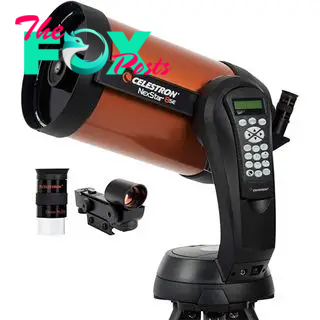
Best overall
Known for its legendary optical performance, compact cassegrain design, and attractive orange coloring, the NexStar 8SE is a fantastic telescope — although it's a much higher investment than others in this list.
Read more below
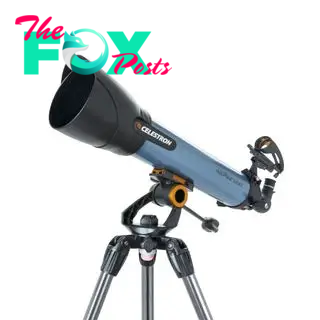
Best for beginners
This refractor telescope is great for beginner astronomers as it has the widest aperture in the Inspire lineup, providing the brightest views possible. It's also budget-friendly.
Read more below

Best advanced telescope
Premium price means premium views and this Schmidt-Cassegrain from Celestron provides some of the best around. It's solidly built, but it's bigger and heavier than other models and better suited for advanced astronomers.
Read more below
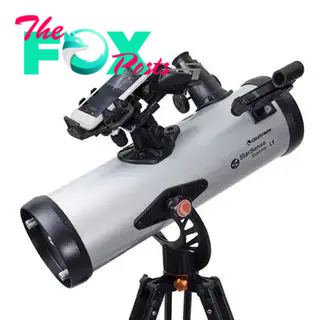
Best for smartphones
With an easy-to-use Alt-azimuth mount, and a mightily impressive f/9 focal ratio, this beginner-friendly reflector also has a smartphone mount for easy guided tours of the night sky through the StarSense app.
Read more below

Best mid-range telescope
This Newtonian reflector is a brilliant telescope for astronomers who want clear views of the night sky and are familiar with telescopes. It's affordable and produces stunning views, but beginners may struggle with it.
Read more below

Best budget smart telescope
A fantastic gateway into stargazing for enthusiastic amateurs or experienced astronomers who want an impressive piece of kit that you won't outgrow in a hurry.
Read more below
- Back to the top ⤴
Best telescopes we recommend in 2024
Why you can trust Live Science Our expert reviewers spend hours testing and comparing products and services so you can choose the best ones for you. Find out more about how we test.
Best telescope overall
✅ You want a long-term investment: This is a telescope hat will last you for decades.
✅ You can afford to: Good quality instruments are rarely cheap, and this one is no exception.
❌ You're a beginner: It's probably a little advanced for beginner astronomers.
❌ You want something rechargeable: It uses 8 x AA batteries to work which could get expensive — you could always invest in rechargeable batteries though.
🔎 Celestron NexStar 8SE: Legendary astronomy performance in a neat little package, the Celestron NexStar 8SE Computerized Telescope gives ultra-bright, clear views of the universe. ★★★★½
Back in the 1980s Celestron made big waves among astronomers with their orange-tubed Schmidt-Cassegrains and, 40-something years on, this line is still fantastic value and gives superb optical performance.
Superbly sharp and bright thanks to the 8-inch aperture and powerful with a focal length of 2032mm, the NexStar 8SE sits atop a strong, sturdy motorized single fork arm mount which can be controlled via either the hand controller or through a computer by use of its ethernet connection.
This is our favorite of all telescopes due to its compact catadioptric design which combines technology from refractors and reflectors to deliver a powerful view of the cosmos at a fraction of the weight and size, as we mentioned in our Celestron NexStar 8SE review.
It's great for upgrading too, with serious astronomers able to go their whole skywatching lives with just this telescope provided they invest in some tasty accessories. Most will update certain items like image diagonals and seek out different eyepieces so a myriad of objects are easy to view and others will update the tripod, though the one that ships straight out of the box is certainly sturdy enough.
The 8SE requires a little more investment than others on this list though, so beginners may be put off but at this premium price, you get a premium product.
- Read our full Celestron NexStar 8SE review
| Attributes | Notes |
|---|---|
| Design | Compact and clutter free. |
| Performance | Stunning clarity thanks to excellent optical characteristics. |
| Functionality | Requires 8 x AA batteries. |
- Back to the top ⤴
Best for beginners
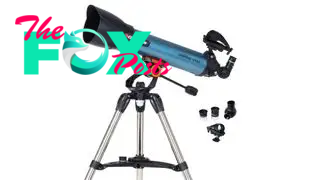
✅ You want to take photos on your smartphone: The lens cap turns into a smartphone holder so you can take astrophotos.
❌ You're an experienced astronomer: It's aimed more towards beginners, so it likely wouldn't be enough for more experienced users.
❌ You want to view deep-space objects: They lack the wow factor, it's better for lunar and planetary views.
🔎 Celestron Inspire 100AZ: An ideal telescope for budding astronomers — it's easy to set up and take down, and has everything you need to get started. ★★★★
We highly recommend this refractor telescope for astronomers who are just getting started because it has the widest aperture in the Inspire lineup and so will provide the brightest views possible. We were impressed with it when we reviewed the Celestron Inspire 100AZ over on our sister site.
It's bundled with everything astronomers need to get started, including an Alt-az mount, erect image star diagonal, StarPointer pro red dot finderscope and two eyepieces (10mm and 25mm) to view a variety of objects. Also included in the package is a red LED flashlight to aid set up at night and protect night vision.
Cleverly, Celestron has even included an integrated smartphone adapter that users can make with the dust cap so that astronomers can use the Celestron app to help guide them to nearby constellations and deep sky objects if they are not already familiar with the night sky.
While this refractor is a budget-friendly option, it does come with glass that produces slight false color issues, so it may not quite suffice for more advanced users, but it shouldn’t be an issue for beginners.
- Head over to our sister site to read a full Celestron Inspire 100AZ review
| Attributes | Notes |
|---|---|
| Design | Lightweight but not particularly compact. |
| Performance | Excels with lunar views, not so much with deep sky objects. |
| Functionality | Easy set-up and take-down. |
- Back to the top ⤴
Best advanced telescope
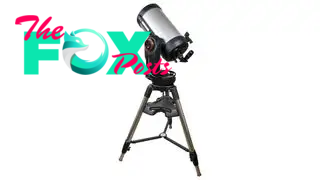
✅ You want GoTo technology: This is an outstanding GoTo telescope.
✅ You want an all-rounder: It's excellent for viewing planets, galaxies and nebulas.
❌ You want something lightweight: It's quite heavy and bulky, so not the most portable.
❌ You're a beginner: It's very advanced and likely too expensive for beginners.
🔎 Celestron NexStar Evolution 9.25: More suited to passionate and advanced skywatchers, this impressive GoTo scope can give a comprehensive tour of the universe. ★★★★½
This Schmidt-Cassegrain is an excellent catadioptric telescope for observing the night sky because it provides clear, sharp images with minimal distortions thanks in part to the StarBright XLT optical coatings.
Its 9.25-inch aperture drinks in the dim, distant starlight and combined with its 2350mm focal length will make short work of even the smallest deep sky objects, provided the correct eyepiece is used. It excels at viewing various night sky objects, from planets to deep-sky nebulas and galaxies — it's a fantastic all-rounder. It's also great for long-exposure astrophotography, too.
In the eyepieces (13mm and 40mm), celestial objects stand out with sharp clarity and striking contrast. This telescope is heavy and durable, which means it’ll remain stable even in strong wind on location, but that also makes it slightly more challenging to transport.
A rechargeable lithium-ion (LiFePO4) gives up to 10 hours of continuous observing and is a welcome change to replacing AA batteries that feature in many other motorized telescopes.
- Just starting out with astrophotography? Check out our beginner's guide to astrophotography.
| Attributes | Notes |
|---|---|
| Design | Bulkier and heavier than other models. |
| Performance | Crisp, clear views. |
| Functionality | Rechargeable and gives 10 hours of continuous observing. |
- Back to the top ⤴
Best for smartphones
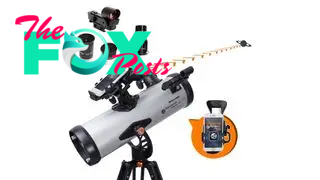
✅ You're a beginner: It lacks the quality needed for more advanced astronomy, but will suit beginners who want to look at the moon and planets.
❌ You want to view deep-space objects: It's better for lunar and planetary views.
🔎 Celestron StarSense Explorer LT 114AZ: An affordable entry-level telescope for beginners, it's easy to use with the StarSense app and provides decent views of the moon and planets, but you'll want to upgrade for anything more. ★★★
The Celestron StarSense Explorer LT 114AZ bucks the trend slightly by simply being a reflector on an alt-azimuth mount. This is ideal for beginners who want to get better views of the dim night sky because alt-az mounts are slightly easier to set up and get going than their equatorial counterparts.
Due to the quick setup and good views through the 10mm and 25mm eyepieces, astronomers can view a wide range of different objects relatively easily, we appreciated this when we reviewed the Celestron StarSense Explorer LT 114AZ on our sister site. It's suitable for transportation as well, weighing just 4.72 kg (10.41 lbs) so users can observe either in the backyard or out on location under darker skies.
Install the StarSense app on your smartphone, then use the finderscope and one of the provided eyepieces to align the camera with the night sky. The app will discern your viewing orientation and intelligently determine what is in view. Additionally, it will provide details on the object in view, allowing newcomers to Astronomy to practice using their equipment while also learning more about the night sky.
- Head over to our sister site to read a full Celestron StarSense Explorer LT 114AZ review
| Attributes | Notes |
|---|---|
| Design | Lightweight, flimsy tripod. |
| Performance | Best for viewing the moon and planets. |
| Functionality | Excellent StarSense app. |
- Back to the top ⤴
Best affordable computerized telescope
✅ You want something lightweight and easily portable: Weighing 16 lbs (7.25 kg), it's easy to transport to dark sky locations.
❌ You're an experienced astronomer: This telescope is more suited to beginners and enthusiasts.
🔎 Celestron Astro Fi 102: A no-frills telescope best suited toward lunar and planetary observing. The motorized mount may take some time for beginners to get set up but it comes in at a reasonable price offering fair views of the night sky. ★★★½
Computerized, motorized telescopes like the Celestron Astro Fi 102 here, make it easy for astronomers to locate and find their night sky objects without having an in-depth knowledge of constellations. The Astro Fi 102 is controllable via an app on a smart device that can be conveniently strapped to the integrated smartphone holder on the dust cap of the telescope. We found the simple design easy to use during our Celestron Astro Fi 102 review.
Then it's just a case of tapping into the app to decide which celestial object should be viewed and the telescope will automatically slew to the target using an in-built motor in the fork arm mount.
The Astro Fi 102 comes with everything an astronomer needs to get started. A lightweight aluminum tripod comes with the bundle, as does a red dot finderscope, two eyepieces (25mm and 10mm), a star diagonal for easier viewing, and an accessory tray.
The telescope is also compatible with iPad, iPhone and Android devices.
- Read our full Celestron Astro Fi 102 review
| Attributes | Notes |
|---|---|
| Design | Lightweight, but build quality isn't great. |
| Performance | Fair views in the center of the image circle. |
| Functionality | Simple controls make it a dream to use. |
- Back to the top ⤴
Best mid-range telescope
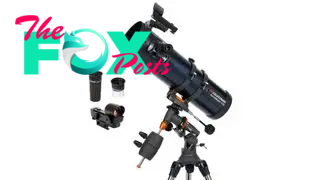
✅ You want to take long exposure images: The motor can track the Earth's movement to take multiple long exposure images to stack.
❌ You're a beginner: Although the price is beginner-friendly, the mount is not.
🔎 Celestron AstroMaster 130EQ: Ideal for intermediate users, the equatorial mount enables you to take multiple long-exposure images for beautiful astrophotographs.
This Newtonian reflector is the right telescope for astronomers who desire clear views of the night sky and have used a few telescopes before.
This reflector ships with a more accurate equatorial mount which utilizes counterweights for steadier and more precise views. Because of this, it's not necessarily suitable for beginners, though those with the tenacity will enjoy it once mastered. Once set up though, the motor is superb for tracking celestial objects as the earth rotates through the night.
With a camera adapter, this makes it easy to take long exposure images of the night sky. By tracking a subject with the earth’s rotation, users can image a subject tens or hundreds of times to attain the dark and light frames required for astrophotographic post-processing.
- Into astrophotography? Read our best cameras for astrophotography guide
| Attributes | Notes |
|---|---|
| Design | Sturdy steel tripod with accessory tray. |
| Performance | Motor is superb for tracking celestial objects. |
| Functionality | Wide 130mm aperture. |
- Back to the top ⤴
Best budget smart telescope
✅ You live in a city: The Smart Light Pollution Reduction feature can eliminate sky glow in cities and urban areas.
✅ You want something simple: It's very easy to set up and use, especially for beginners.
❌ You're on a budget: If you're on a budget, perhaps a smart telescope isn't the way to go.
❌ You want to view the moon: We found the lunar views a bit disappointing.
🔎 Unistellar eQuinox 2: Designed for beginners with no experience or power astronomers who simply don't have the time or patience to set up traditional telescopes, this smart telescope can find celestial objects in a matter of seconds. ★★★★½
If you're looking for a telescope to take the hassle out of astronomy then the Unistellar eQuinox 2 might just be the one for you. It's the second smart telescope to appear on this list and was put together by Unistellar who specialize in smart telescope technology. This is a slight departure from the eVscope 2 (noted above) and is the latest of the releases but it replaces the original eQuinox telescope.
The eQuinox line is a little less impressive feature-wise than its eVscope counterpart but that's because it's a more affordable, entry-level variant. As such, we found it to be incredibly easy to set up and use during our Unistellar eQuinox 2 review — assembly is just a couple of screws to attach the scope to the tripod.
Once that's done, sync it up to the app and you're away. The catalog mode means you can easily pick a celestial object from the list and the Unistellar eQuinox 2 will automatically find it in the night sky. The app has a huge collection of known objects saved, including galaxies, planets, nebula and stars.
It also features an Enhanced view mode, which intelligently layers multiple long-exposure images together to provide more detailed images. We found that the Unistellar eQuinox 2 is particularly great for getting images of galaxies even from the backyard.
Smart telescopes aren't for everyone, and they're not going to replace traditional options for most astronomers, but we think the Unistellar eQuinox 2 is a fantastic gateway into the hobby for enthusiastic amateurs or experienced astronomers who want a low-effort option to supplement their other scopes.
- Read our full Unistellar eQuinox 2 review
| Attributes | Notes |
|---|---|
| Design | Attractive modern aesthetics. |
| Performance | Fantastic, detailed views of galaxies and nebulas when using Enhanced View mode. |
| Functionality | Tricky to travel with unless using Unistellar bag (for an additional cost). |
- Back to the top ⤴
Best premium smart telescope
✅ You're an experienced astronomer or astrophotographer: The overall performance and image quality are likely reserved for experienced users.
✅ You like tech: Smart telescopes are full of impressive tech.
❌ You don't have a big budget: It's eye-wateringly expensive.
❌ You're more traditional: Purists may miss using an eyepiece.
🔎 Unistellar eVscope 2: Unistellar has clearly gone over each tiny aspect of the eVscope 2’s design and every inch feels and looks premium. ★★★★½
This beautiful-looking telescope from Unistellar is the second in the eVscope line and comes with a boost in specifications and function. A futuristic telescope for the digital age — this is a smart telescope. Everything on it is automatic, from set-up to imaging and anyone can use it because it requires no prior knowledge of the constellations or any part of the night sky. We were incredibly impressed with it during our Unistellar eVscope 2 review.
Most smart telescopes have a drawback for traditional astronomers who prefer using an eyepiece because they don't have one, instead, the telescope is viewed through a smartphone or tablet via an app. However, this wonderful-looking telescope has a micro OLED digital eyepiece developed by Nikon and it captures 7.7MP stills photos of the cosmos with image-enhanced options available through the smart device app.
The telescope comes with its own tripod and an additional backpack (which we recommend) making it truly simple to carry around on location. Photographers will find this telescope much more familiar than the aged designs of other, more traditional telescopes. It can automatically identify stars and constellations and the app will suggest subjects based on location and time, automatically slewing to them with the press of the screen.
- Read our full Unistellar eVscope 2 review
| Attributes | Notes |
|---|---|
| Design | Unique, minimalist design good for all astronomers. |
| Performance | Manual telescope control via the app is speedy. |
| Functionality | Easy to set up and carry. |
- Back to the top ⤴
Best for intermediates

✅ You want a good all-rounder: It produces good views of the moon, planets and galaxy clusters.
❌ You're a beginner: Beginners may struggle with the mount if they aren't familiar with EQ mounts.
🔎 Orion StarBlast II 4.5 EQ: For generalist observations at an affordable price, this is a good option to go for. It's not perfect, but it produces decent views of the moon, planets and galaxy clusters. ★★★★
The Orion StarBlast II 4.5 is a good quality all-round reflector housed in a compact design for any astronomer who wants to view a bit of everything while keeping costs down. Beginners may find the equatorial mount slightly more difficult to put up than a conventional alt-azimuth mount, but the results are worth it when you persevere.
It comes with two eyepieces (10mm and 25mm) and also, happily, a 2x Barlow lens to increase reach when viewing longer distance night sky objects.
That said, it's worth bearing in mind the highest maximum magnification capabilities of this telescope to avoid being disappointed by poor views.
Inside the box, astronomers will also discover an EZ Finder II reflex sight, a tripod and a MoonMap 260 to aid you through your first observations.
- Looking for something a bit smaller? Check out a pair of the best binoculars for stargazing
| Attributes | Notes |
|---|---|
| Design | Tripod is a little flimsy. |
| Performance | Good for generalist observations. |
| Functionality | Beginners may struggle with the EQ mount. |
- Back to the top ⤴
Best for quick setup

✅ You live in a city: It has a City Light Suppression feature to cut out light pollution from cities and urban areas.
❌ You want to view planets: It's more suited to deep-sky nebulas and galaxies rather than detailed images of planets.
🔎 Vaonis Stellina: An easy-to-control smart telescope that produces images of the night sky almost instantly. Keep in mind that it's quite heavy, although easy to transport. Plus it's very expensive. ★★★★
In stark contrast to the majority of other telescopes on the market, the Vaonis Stellina telescope is coined as an observation station and smart or hybrid telescope due to its design. It requires no eyepieces or finderscopes and instead relies on a CMOS image sensor (made by Sony) to capture images via wireless smartphone connection.
Designed to turn on and get going immediately, the Stellina can give views and photograph the cosmos almost instantly from the minute it's powered on. We were very impressed when we reviewed the Vaonis Stellina on our sister site. No additional gear is required to take photos as this automatic function through the smartphone app is aided by autonomous tracking of the night sky to keep things sharp.
There's also no lengthy star alignment, with the telescope capable of identifying constellations and stars itself — perfect for beginners. Navigate and take photos using the smart device app using its database of 100 objects.
- Head over to our sister site to read a full Vaonis Stellina review
| Attributes | Notes |
|---|---|
| Design | Neat, compact design in a single unit. |
| Performance | Good quality color even with light pollution. |
| Functionality | Images appear within seconds. |
- Back to the top ⤴
How we test telescopes
Live Science tests a large range of products, from rowing machines to binoculars for stargazing. To give readers the best buying advice possible, we subject products we review to rigorous tests, which may include in-lab benchmarks and extensive use in our test centers.
We always want to see how products live up to the promises of their manufacturers, and we often call in experts for their opinions. Products are evaluated on factors such as how easy they are to use, their success compared to their competitors, and their value for money.
Live Science is confident that with this combination of research, extensive testing, and expert consultation, readers will be able to make better-informed buying decisions.
- Back to the top ⤴
Telescope questions answered
What is the best telescope overall?
For our money, we'd recommend the Celestron NexStar 8SE as the best telescope overall due to its excellent optical clarity, powerful focal length, top-class customization and durable build quality.
What is the best telescope for beginners?
We think the Celestron Inspire 100AZ is the best telescope for beginners who are happy to invest in a refractor. Its easy operation is due to its simple, camera lens-like design and Alt-azimuth mount that is fast to get observing with.
What is the best smart telescope?
For those with the budget we'd recommend the Unistellar eVscope 2 because it can be operated by anyone with the compatible smartphone app and it takes amazing astrophotographs right from your phone.
Do I need a computerized telescope?
Technically, no. As long as you are happy to manually slew the telescope to the next night sky object and use your knowledge of the stars to navigate (or use a proprietary stargazing app that comes with the telescope) then a non-computerized telescope is fine. However, computerized telescopes are motorized and can be programmed to find specific celestial objects with a controller or smartphone app which makes it faster and more accurate for beginners.
Which is better for astronomy, telescopes or binoculars?
While there are undoubtedly some powerful and optically proficient binoculars specifically designed for astronomy they are limited in terms of customization and aren't ideal for viewing smaller objects.
Telescopes, therefore, are much more suited to those that have the aforementioned requirements. However, they lack a stereoscopic view.
What type of telescope should I buy?
Refractors are commonly better for entry-level observers because their construction and operation is slightly more similar to how a camera lens works and most new observers are used to taking pictures.
Reflectors offer greater reach in shorter bodies, though they are typically wider in diameter and can take a little longer to set-up (collimate).
Catadioptrics are a hybrid between the two types above which means they are small but have fantastic reach. They tend to cost much more though and may be out of the budgets of many just getting started.
- Back to the top ⤴
-

 Science2d ago
Science2d agoInside Capitol Hill’s Latest UFO Hearings
-

 Science2d ago
Science2d agoYou Won’t Want to Miss the Leonid Meteor Shower. Here’s How and When You Can See It
-

 Science3d ago
Science3d agoHere’s What Trump’s Win Means for NASA
-

 Science6d ago
Science6d agoWhy Risky Wildfire Zones Have Been Increasing Around the World
-

 Science6d ago
Science6d agoIt’s Time to Redefine What a Megafire Is in the Climate Change Era
-

 Science1w ago
Science1w ago4 Astronauts Return to Earth After Being Delayed by Boeing’s Capsule Trouble and Hurricane Milton
-

 Science1w ago
Science1w agoThe Elegance and Awkwardness of NASA’s New Moon Suit, Designed by Axiom and Prada
-

 Science1w ago
Science1w agoSpaceX Launches Its Mega Starship Rocket. This Time, Mechanical Arms Catch It at Landing




























